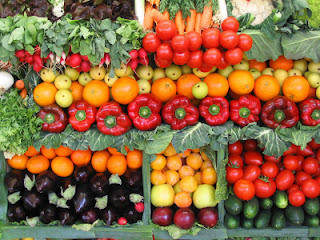 |
| photo via worldcommunitycookbook.org |
If we apply the statement 'You are what you eat" to Okinawans, we observe several interesting ingredients in their diet. You guessed it. Soy is definitely in there--in the form of tofu, miso, edamame. They don't just use it in stir-frys. They use it in cheesecake, salad dressing, and more. The thing to do is just start experimenting. (Remember we recently used it in pumpkin pie!)
Bitter melon is another ingredient (a relative of cucumber and very high in vitamin C). This one--you've no doubt been eating for years--carrots. But don't toss the tops! That's right. Before you head to the compost pile, chop up those tops and add to vegetable soup or scrambled eggs (or tofu scramble!)
Hechima, a gourd that can be found at Asian markets, is great with tofu. Use it like you would zucchini. In fact, if you can't find any hechima--use zucchini! Okinawans are free with the herbs--turmeric (which fights inflmmation), chili (good for the heart), fennel (nice for the digestion). . . get creative. Herbs are your friends.
Seaweed--so full of folate, iron, and magnesium, is also full of lignan, a cancer-fighting phytoestrogen. Try them in salads, soups. Make your own pseudo sushi by wrapping small balls of rice (or tofu) in strips of seaweed.
Sweet potatoes are sweet. Very sweet for your health. Antioxidant as all get-out and so delicious. Make sweet potato fries by slicing sweet potatoes julienne style, put on a cookie sheet, douse with olive oil, and sprinkle with as much cayenne as you dare and pepper. Put in a 300-350 degree oven for about 25 minutes. Just 'til you see them start to brown. If you're watching your sodium, know that the bite of the cayenne pretty much replaces the salt and you can eat to your heart's content. . . (literally and figuratively).
Okinawans know the riches of whole grains--millet, rice, barley.
Now it's not just what you put in your bodies, it's how you treat daily life. Slow down, be kind, do something to make someone happy. You're doing everyone a favor, because studies show that strong social ties are linked to low rates of just about everything you don't want. . .
A toast to good heath! And let's bring in the new year with good intentions, understanding, and being good to the planet and ourselves.




